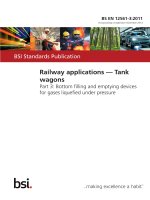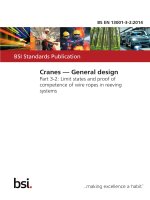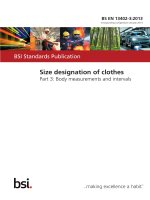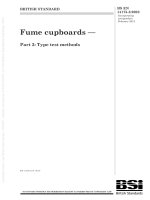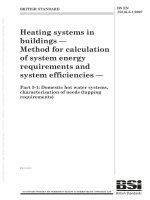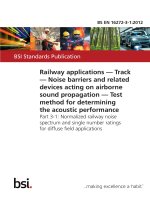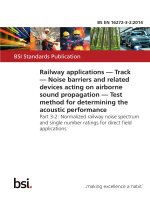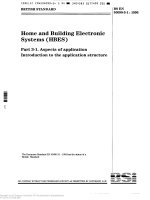Bsi bs en 61158 3 1 2014
Bạn đang xem bản rút gọn của tài liệu. Xem và tải ngay bản đầy đủ của tài liệu tại đây (2.95 MB, 132 trang )
BS EN 61158-3-1:2014
BSI Standards Publication
Industrial communication
networks — Fieldbus
specifications
Part 3-1: Data-link layer service
definition — Type 1 elements
BS EN 61158-3-1:2014 BRITISH STANDARD
National foreword
This British Standard is the UK implementation of EN 61158-3-1:2014. It
is identical to IEC 61158-3-1:2014. It supersedes BS EN 61158-3-1:2008
which is withdrawn.
The UK participation in its preparation was entrusted to Technical Com-
mittee AMT/7, Industrial communications: process measurement and
control, including fieldbus.
A list of organizations represented on this committee can be obtained on
request to its secretary.
This publication does not purport to include all the necessary provisions of
a contract. Users are responsible for its correct application.
© The British Standards Institution 2014.
Published by BSI Standards Limited 2014
ISBN 978 0 580 79361 5
ICS 25.040.40; 35.100.20; 35.240.50
Compliance with a British Standard cannot confer immunity from
legal obligations.
This British Standard was published under the authority of the
Standards Policy and Strategy Committee on 31 October 2014.
Amendments/corrigenda issued since publication
Date Text affected
EUROPEAN STANDARD EN 61158-3-1
NORME EUROPÉENNE
EUROPÄISCHE NORM October 2014
ICS 35.100.20; 35.110; 25.040.40 Supersedes EN 61158-3-1:2008
English Version
Industrial communication networks - Fieldbus specifications -
Part 3-1: Data-link layer service definition - Type 1 elements
(IEC 61158-3-1:2014)
Réseaux de communication industriels - Spécifications des Industrielle Kommunikationsnetze - Feldbusse - Teil 3-1:
bus de terrain - Partie 3-1: Définition des services de la Dienstfestlegungen des Data Link Layer
couche liaison de données - Éléments de type 1 (Sicherungsschicht) - Typ 1-Elemente
(CEI 61158-3-1:2014) (IEC 61158-3-1:2014)
This European Standard was approved by CENELEC on 2014-09-17. CENELEC members are bound to comply with the CEN/CENELEC
Internal Regulations which stipulate the conditions for giving this European Standard the status of a national standard without any alteration.
Up-to-date lists and bibliographical references concerning such national standards may be obtained on application to the CEN-CENELEC
Management Centre or to any CENELEC member.
This European Standard exists in three official versions (English, French, German). A version in any other language made by translation
under the responsibility of a CENELEC member into its own language and notified to the CEN-CENELEC Management Centre has the
same status as the official versions.
CENELEC members are the national electrotechnical committees of Austria, Belgium, Bulgaria, Croatia, Cyprus, the Czech Republic,
Denmark, Estonia, Finland, Former Yugoslav Republic of Macedonia, France, Germany, Greece, Hungary, Iceland, Ireland, Italy, Latvia,
Lithuania, Luxembourg, Malta, the Netherlands, Norway, Poland, Portugal, Romania, Slovakia, Slovenia, Spain, Sweden, Switzerland,
Turkey and the United Kingdom.
European Committee for Electrotechnical Standardization
Comité Européen de Normalisation Electrotechnique
Europäisches Komitee für Elektrotechnische Normung
CEN-CENELEC Management Centre: Avenue Marnix 17, B-1000 Brussels
© 2014 CENELEC All rights of exploitation in any form and by any means reserved worldwide for CENELEC Members.
Ref. No. EN 61158-3-1:2014 E
BS EN 61158-3-1:2014
EN 61158-3-1:2014 - 2 -
Foreword
The text of document 65C/759/FDIS, future edition 2 of IEC 61158-3-1, prepared by SC 65C
"Industrial networks" of IEC/TC 65 "Industrial-process measurement, control and automation" was
submitted to the IEC-CENELEC parallel vote and approved by CENELEC as EN 61158-3-1:2014.
The following dates are fixed:
• latest date by which the document has to be implemented at (dop) 2015-06-17
national level by publication of an identical national
standard or by endorsement
• latest date by which the national standards conflicting with (dow) 2017-09-17
the document have to be withdrawn
This document supersedes EN 61158-3-1:2008.
Attention is drawn to the possibility that some of the elements of this document may be the subject of
patent rights. CENELEC [and/or CEN] shall not be held responsible for identifying any or all such
patent rights.
This document has been prepared under a mandate given to CENELEC by the European Commission
and the European Free Trade Association.
Endorsement notice
The text of the International Standard IEC 61158-3-1:2014 was approved by CENELEC as a
European Standard without any modification.
In the official version, for Bibliography, the following notes have to be added for the standards indicated:
IEC 61158-1 NOTE Harmonized as EN 61158-1.
IEC 61158-2 NOTE Harmonized as EN 61158-2.
IEC 61158-4-1 NOTE Harmonized as EN 61158-4-1.
IEC 61158-5-9 NOTE Harmonized as EN 61158-5-9.
IEC 61158-6-9 NOTE Harmonized as EN 61158-6-9.
IEC 61784-1 NOTE Harmonized as EN 61784-1.
IEC 61784-2 NOTE Harmonized as EN 61784-2.
BS EN 61158-3-1:2014
- 3 - EN 61158-3-1:2014
Annex ZA
(normative)
Normative references to international publications
with their corresponding European publications
The following documents, in whole or in part, are normatively referenced in this document and are
indispensable for its application. For dated references, only the edition cited applies. For undated
references, the latest edition of the referenced document (including any amendments) applies.
NOTE 1 When an International Publication has been modified by common modifications, indicated by (mod),
the relevant EN/HD applies.
NOTE 2 Up-to-date information on the latest versions of the European Standards listed in this annex is
available here: www.cenelec.eu.
Publication Year Title EN/HD Year
ISO/IEC 7498-1 - - -
Information technology - Open Systems
ISO/IEC 7498-3 - Interconnection - Basic Reference Model: - -
The Basic Model
ISO/IEC 10731 1994 - -
Information technology - Open Systems
Interconnection - Basic Reference Model:
Naming and addressing
Information technology - Open Systems
Interconnection - Basic Reference Model -
Conventions for the definition of OSI
services
– 2 – BS EN 61158-3-1:2014
IEC 61158-3-1:2014 © IEC 2014
CONTENTS
0 INTRODUCTION ..............................................................................................................9
0.1 General ...................................................................................................................9
0.2 Nomenclature for references within this standard ....................................................9
1 Scope............................................................................................................................. 10
1.1 General ................................................................................................................. 10
1.2 Specifications ........................................................................................................ 10
1.3 Conformance......................................................................................................... 10
2 Normative references ..................................................................................................... 11
3 Terms, definitions, symbols, abbreviations and conventions ........................................... 11
3.1 Reference model terms and definitions .................................................................. 11
3.2 Service convention terms and definitions ............................................................... 12
3.3 Data-link service terms and definitions .................................................................. 13
3.4 Common symbols and abbreviations ..................................................................... 16
3.5 Common conventions ............................................................................................ 17
4 Overview of the data-link layer service ........................................................................... 19
4.1 General ................................................................................................................. 19
4.2 Types and classes of data-link layer service.......................................................... 21
4.3 Quality-of-service (QoS) attributes common to multiple types of data-link
layer service.......................................................................................................... 22
5 DL(SAP)-address, queue and buffer management data-link layer service ....................... 27
5.1 Facilities of the DL(SAP)-address, queue and buffer management data-link
layer service.......................................................................................................... 27
5.2 Model of the DL(SAP)-address, queue and buffer management data-link
layer service.......................................................................................................... 27
5.3 Sequence of primitives at one DLSAP ................................................................... 27
5.4 DL(SAP)-address, queue and buffer management facilities ................................... 29
6 Connection-mode data-link layer service ........................................................................ 43
6.1 Facilities of the connection-mode data-link layer service ....................................... 43
6.2 Model of the connection-mode data-link layer service............................................ 44
6.3 Quality of connection-mode service ....................................................................... 51
6.4 Sequence of primitives .......................................................................................... 57
6.5 Connection establishment phase ........................................................................... 68
6.6 Connection release phase ..................................................................................... 75
6.7 Data transfer phase ............................................................................................... 81
7 Connectionless-mode data-link layer service .................................................................. 93
7.1 Facilities of the connectionless-mode data-link layer service ................................. 93
7.2 Model of the connectionless-mode data-link layer service ..................................... 93
7.3 Quality of connectionless-mode service................................................................. 95
7.4 Sequence of primitives .......................................................................................... 95
7.5 Connectionless-mode functions ............................................................................. 98
8 Time and scheduling guidance data-link layer service .................................................. 109
8.1 Facilities and classes of the time and scheduling guidance data-link layer
service ................................................................................................................ 109
8.2 Model of the time and scheduling guidance data-link layer service ...................... 110
8.3 Quality of scheduling guidance service ................................................................ 110
8.4 Sequence of primitives at one DLE ...................................................................... 110
BS EN 61158-3-1:2014 – 3 –
IEC 61158-3-1:2014 © IEC 2014
8.5 Scheduling guidance functions ............................................................................ 112
9 DL-management service ............................................................................................... 123
9.1 Scope and inheritance ......................................................................................... 123
9.2 Facilities of the DL-management service ............................................................. 123
9.3 Model of the DL-management service.................................................................. 123
9.4 Constraints on sequence of primitives ................................................................. 123
9.5 Set ...................................................................................................................... 124
9.6 Get ...................................................................................................................... 125
9.7 Action.................................................................................................................. 125
9.8 Event .................................................................................................................. 126
Bibliography........................................................................................................................ 128
Figure 1 – Relationships of DLSAPs, DLSAP-addresses, DLCEPs, DLCEP-addresses,
DLSEP-addresses and group DL-addresses ......................................................................... 14
Figure 2 – Example of paths, links, bridges, and the extended link .......................................20
Figure 3 – Types of DL-timeliness In terms of elapsed DL-time and events at the
assessing DLCEP ................................................................................................................. 25
Figure 4 – Sequence of primitives for the DL(SAP)-address, queue and buffer
management DLS ................................................................................................................. 29
Figure 5 – Supported methods of data management for transmission and delivery................30
Figure 6 – Peer-to-peer and multi-peer DLCs and their DLCEPs ........................................... 44
Figure 7 – OSI abstract queue model of a peer DLC between a pair of DLS-users ................45
Figure 8 – OSI abstract queue model of a multi-peer DLC between a publishing DLS-
user and a set of subscribing DLS-users ............................................................................... 49
Figure 9 – Summary of DL-connection-mode service primitive time-sequence diagrams
for peer DLCs (portion 1) ...................................................................................................... 61
Figure 10 – Summary of DL-connection-mode service primitive time-sequence
diagrams for peer DLCs (portion 2) ...................................................................................... 62
Figure 11 – Summary of DL-connection-mode service primitive time-sequence
diagrams for publishers of a multi-peer DLC (portion 1) ....................................................... 63
Figure 12 – Summary of DL-connection-mode service primitive time-sequence
diagrams for publishers of a multi-peer DLC (portion 2) ....................................................... 64
Figure 13 – Summary of additional DL-connection-mode service primitive time-
sequence diagrams for a multi-peer DLC subscriber where the diagrams differ from the
corresponding ones for a publisher (portion 1) ...................................................................... 65
Figure 14 – Summary of additional DL-connection-mode service primitive time-
sequence diagrams for a multi-peer DLC subscriber where the diagrams differ from the
corresponding ones for a publisher (portion 2) ...................................................................... 66
Figure 15 – State transition diagram for sequences of DL-connection-mode service
primitives at a DLCEP........................................................................................................... 67
Figure 16 – Peer DLC/DLCEP establishment initiated by a single DLS-user..........................73
Figure 17 – Multi-peer DLC/DLCEP establishment initiated by the publishing DLS-user ........74
Figure 18 – Multi-peer DLC/DLCEP establishment initiated by a subscribing DLS-user .........74
Figure 19 – Multi-peer DLC/DLCEP establishment using known DLCEP addresses
initiated first by the publishing DLS-user ............................................................................... 74
Figure 20 – Multi-peer DLC/DLCEP establishment using known DLCEP addresses
initiated first by one or more subscribing DLS-users ............................................................. 74
Figure 21 – Peer DLC/DLCEP establishment initiated simultaneously by both peer
DLS-users, resulting in a merged DLC .................................................................................. 75
– 4 – BS EN 61158-3-1:2014
IEC 61158-3-1:2014 © IEC 2014
Figure 22 – Multi-peer DLC/DLCEP establishment initiated simultaneously by both
publishing and subscribing DLS-users, resulting in a merged DLC ........................................ 75
Figure 23 – Peer DLS-user invocation................................................................................... 78
Figure 24 – Publishing DLS-user invocation.......................................................................... 78
Figure 25 – Subscribing DLS-user invocation........................................................................ 78
Figure 26 – Simultaneous invocation by both DLS-users....................................................... 78
Figure 27 – Peer DLS-provider invocation............................................................................. 78
Figure 28 – Publishing DLS-provider invocation .................................................................... 78
Figure 29 – Subscribing DLS-provider invocation .................................................................. 78
Figure 30 – Simultaneous peer DLS-user and DLS-provider invocations ...............................78
Figure 31 – Simultaneous publishing DLS-user and DLS-provider invocations ......................79
Figure 32 – Simultaneous subscribing DLS-user and DLS-provider invocations ....................79
Figure 33 – Sequence of primitives in a peer DLS-user rejection of a DLC/DLCEP
establishment attempt........................................................................................................... 79
Figure 34 – Sequence of primitives in a publishing DLS-user rejection of a DLC/DLCEP
establishment attempt........................................................................................................... 79
Figure 35 – Sequence of primitives in a subscribing DLS-user rejection of a
DLC/DLCEP establishment attempt....................................................................................... 79
Figure 36 – Sequence of primitives in a DLS-provider rejection of a DLC/DLCEP
establishment attempt........................................................................................................... 80
Figure 37 – Sequence of primitives in a DLS-user cancellation of a DLC/DLCEP
establishment attempt: both primitives are destroyed in the queue........................................80
Figure 38 – Sequence of primitives in a DLS-user cancellation of a DLC/DLCEP
establishment attempt: DL-DISCONNECT indication arrives before DL-CONNECT response
is sent................................................................................................................................... 80
Figure 39 – Sequence of primitives in a DLS-user cancellation of a DLC/DLCEP
establishment attempt: peer DL-DISCONNECT indication arrives after DL-CONNECT
response is sent ................................................................................................................... 80
Figure 40 – Sequence of primitives in a DLS-user cancellation of a DLC/DLCEP
establishment attempt: publisher’s DL-DISCONNECT indication arrives after DL-CONNECT
response is sent ................................................................................................................... 81
Figure 41 – Sequence of primitives in a DLS-user cancellation of a DLC/DLCEP
establishment attempt: subscriber’s DL-DISCONNECT request arrives after DL-CONNECT
request has been communicated to the publisher.................................................................. 81
Figure 42 – Sequence of primitives for a CLASSICAL or DISORDERED peer-to-peer
queue-to-queue data transfer................................................................................................ 83
Figure 43 – Sequence of primitives for an ORDERED or UNORDERED peer-to-peer, or an
UNORDERED subscriber-to-publisher queue-to-queue data transfer ........................................ 84
Figure 44 – Sequence of primitives for a publisher-to-subscribers queue-to-queue data
transfer ................................................................................................................................. 84
Figure 45 – Sequence of primitives for a failed queue-to-queue data transfer .......................84
Figure 46 – Sequence of primitives for an ORDERED or UNORDERED peer to peer, or an
UNORDERED subscriber to publisher, buffer to buffer data transfer ......................................... 85
Figure 47 – Sequence of primitives for a publisher to subscribers buffer to buffer data
transfer ................................................................................................................................. 86
Figure 48 – Sequence of primitives for an ORDERED or UNORDERED peer to peer, or an
UNORDERED subscriber to publisher, buffer to queue data transfer ........................................ 86
Figure 49 – Sequence of primitives for a publisher to subscribers buffer to queue data
transfer ................................................................................................................................. 86
BS EN 61158-3-1:2014 – 5 –
IEC 61158-3-1:2014 © IEC 2014
Figure 50 – Sequence of primitives in a peer DLS-user initiated Reset .................................89
Figure 51 – Sequence of primitives in a publishing DLS-user initiated Reset.........................90
Figure 52 – Sequence of primitives in a subscribing DLS-user initiated Reset.......................90
Figure 53 – Sequence of primitives in a simultaneous peer DLS-users initiated Reset ..........90
Figure 54 – Sequence of primitives in a simultaneous multi-peer DLS-users initiated
Reset .................................................................................................................................... 90
Figure 55 – Sequence of primitives in a peer DLS-provider initiated Reset............................90
Figure 56 – Sequence of primitives in a publishing DLS-provider initiated Reset ...................90
Figure 57 – Sequence of primitives in a subscribing DLS-provider initiated Reset .................91
Figure 58 – Sequence of primitives in a simultaneous peer DLS-user and DLS-provider
initiated Reset....................................................................................................................... 91
Figure 59 – Sequence of primitives in a simultaneous publishing DLS-user and DLS-
provider initiated Reset ......................................................................................................... 91
Figure 60 – Sequence of primitives in a simultaneous subscribing DLS-user and DLS-
provider initiated Reset ......................................................................................................... 91
Figure 61 – Sequence of primitives for Subscriber Query...................................................... 92
Figure 62 – Model for a data-link layer connectionless-mode unitdata transmission or
unitdata exchange ................................................................................................................ 94
Figure 63 – Summary of DL-connectionless-mode service primitive time-sequence
diagrams............................................................................................................................... 97
Figure 64 – State transition diagram for sequences of connectionless-mode primitives
at one DLSAP ....................................................................................................................... 98
Figure 65 – Sequence of primitives for a successful locally-acknowledged
connectionless-mode unitdata transfer................................................................................ 101
Figure 66 – Sequence of primitives for a successful remotely-acknowledged
connectionless-mode unitdata transfer................................................................................ 102
Figure 67 – Sequence of primitives for an unsuccessful connectionless-mode unitdata
transfer ............................................................................................................................... 102
Figure 68 – Sequence of primitives for connectionless-mode unitdata exchange................. 107
Figure 69 – Sequence of primitives for connectionless-mode listener query ........................ 108
Figure 70 – Summary of time and scheduling-guidance service primitive time sequence
diagrams............................................................................................................................. 112
Figure 71 – Sequence of primitives for DL-time................................................................... 114
Figure 72 – Sequence of primitives for the Compel-Service service .................................... 116
Figure 73 – Sequence of primitives for the sequence scheduling services........................... 120
Figure 74 – Sequence of primitives for the DLM action service ........................................... 123
Table 1 – Summary of DL(SAP)-address, queue and buffer management primitives and
parameters ........................................................................................................................... 28
Table 2 – DL-buffer-and-queue-management create primitive and parameters ......................30
Table 3 – DL-buffer-and-queue-management delete primitive and parameters ......................33
Table 4 – DL(SAP)-address-management bind primitive and parameters ..............................34
Table 5 – DL(SAP)-role constraints on DLSAPs, DLCEPs and other DLS Primitives .............35
Table 6 – DL(SAP)-address-management unbind primitive and parameters ..........................39
Table 7 – DL-buffer-management put primitive and parameters ............................................ 39
Table 8 – DL-buffer-and-queue-management get primitive and parameters...........................41
Table 9 – Relationships between abstract queue model objects ............................................ 47
– 6 – BS EN 61158-3-1:2014
IEC 61158-3-1:2014 © IEC 2014
Table 10 – Attributes and class requirements of DLCEP data delivery features .....................53
Table 11 – Summary of DL-connection-mode primitives and parameters (portion 1)..............59
Table 12 – Summary of DL-connection-mode primitives and parameters (portion 2)..............60
Table 13 – DLC / DLCEP establishment primitives and parameters (portion 1)......................69
Table 14 – DLC / DLCEP establishment primitives and parameters (portion 2)......................70
Table 15 – DLC / DLCEP release primitives and parameters................................................. 76
Table 16 – Queue data transfer primitive and parameters ..................................................... 81
Table 17 – Buffer sent primitive and parameter ..................................................................... 84
Table 18 – Buffer received primitive and parameter .............................................................. 85
Table 19 – DLC/DLCEP reset primitives and parameters (portion 1) .....................................87
Table 20 – DLC/DLCEP reset primitives and parameters (portion 2) .....................................87
Table 21 – Subscriber query primitives and parameters ........................................................ 92
Table 22 – Summary of DL-connectionless-mode primitives and parameters ........................96
Table 23 – DL-connectionless-mode unitdata transfer primitives and parameters..................99
Table 24 – DL-connectionless-mode unitdata exchange primitive and parameters .............. 103
Table 25 – Listener query primitives and parameters .......................................................... 108
Table 26 – Summary of DL-scheduling-guidance primitives and parameters ....................... 111
Table 27 – DL-time primitive and parameters ...................................................................... 113
Table 28 – DL-scheduling-guidance Compel-service primitive and parameters.................... 114
Table 29 – DL-scheduling-guidance Schedule Sequence primitives and parameters ........... 117
Table 30 – DL-scheduling-guidance Cancel Schedule primitives and parameters................ 121
Table 31 – DL-scheduling-guidance Subset Sequence primitives and parameters............... 122
Table 32 – Summary of DL-management primitives and parameters ................................... 124
Table 33 – DLM-Set primitive and parameters .................................................................... 124
Table 34 – DLM-Get primitive and parameters .................................................................... 125
Table 35 – DLM-Action primitive and parameters ................................................................ 126
Table 36 – DLM-Event primitive and parameters ................................................................. 127
BS EN 61158-3-1:2014 – 9 –
IEC 61158-3-1:2014 © IEC 2014
0 INTRODUCTION
0.1 General
This part of IEC 61158 is one of a series produced to facilitate the interconnection of
automation system components. It is related to other standards in the set as defined by the
“three-layer” fieldbus reference model described in IEC 61158-1.
Throughout the set of fieldbus standards, the term “service” refers to the abstract capability
provided by one layer of the OSI Basic Reference Model to the layer immediately above.
Thus, the data-link layer service defined in this standard is a conceptual architectural service,
independent of administrative and implementation divisions.
0.2 Nomenclature for references within this standard
Clauses, including annexes, can be referenced in their entirety, including any subordinate
subclauses, as “Clause N” or “Annex N”, where N is the number of the clause or letter of the
annex.
Subclauses can be referenced in their entirety, including any subordinate subclauses, as
“N.M” or “N.M.P” and so forth, depending on the level of the subclause, where N is the
number of the subclause or letter of the annex, and M, P and so forth represent the
successive levels of subclause up to and including the subclause of interest.
When a clause or subclause contains one or more subordinate subclauses, the text between
the clause or subclause heading and its first subordinate subclause can be referenced in its
entirety as “N.0” or “N.M.0” or “N.M.P.0” and so forth, where N, M and P are as above. Stated
differently, a reference ending with “.0” designates the text and figures between a clause or
subclause header and its first subordinate subclause.
NOTE This nomenclature provides a means of referencing text in hanging clauses. Such clauses existed in earlier
editions of IEC 61158-3, Type 1 clauses. Those hanging clauses are maintained in this edition to minimize the
disruption to existing national and multi-national standards and consortia documents which reference that prior
subclause numbering.
– 10 – BS EN 61158-3-1:2014
IEC 61158-3-1:2014 © IEC 2014
INDUSTRIAL COMMUNICATION NETWORKS –
FIELDBUS SPECIFICATIONS –
Part 3-1: Data-link layer service definition –
Type 1 elements
1 Scope
1.1 General
This part of IEC 61158 provides common elements for basic time-critical messaging
communications between devices in an automation environment. The term “time-critical” is
used to represent the presence of a time-window, within which one or more specified actions
are required to be completed with some defined level of certainty. Failure to complete
specified actions within the time window risks failure of the applications requesting the
actions, with attendant risk to equipment, plant and possibly human life.
This standard defines in an abstract way the externally visible service provided by the Type 1
fieldbus data-link layer in terms of
a) the primitive actions and events of the service;
b) the parameters associated with each primitive action and event, and the form which they
take; and
c) the interrelationship between these actions and events, and their valid sequences.
The purpose of this standard is to define the services provided to
• the Type 1 fieldbus application layer at the boundary between the application and data-link
layers of the fieldbus reference model;
• systems management at the boundary between the data-link layer and systems
management of the fieldbus reference model.
1.2 Specifications
The principal objective of this standard is to specify the characteristics of conceptual data-link
layer services suitable for time-critical communications, and thus supplement the OSI Basic
Reference Model in guiding the development of data-link protocols for time-critical
communications. A secondary objective is to provide migration paths from previously existing
industrial communications protocols.
This specification may be used as the basis for formal DL-Programming-Interfaces.
Nevertheless, it is not a formal programming interface, and any such interface will need to
address implementation issues not covered by this specification, including
a) the sizes and octet ordering of various multi-octet service parameters;
b) the correlation of paired request and confirm, or indication and response, primitives.
1.3 Conformance
This standard does not specify individual implementations or products, nor does it constrain
the implementations of data-link entities within industrial automation systems.
There is no conformance of equipment to this data-link layer service definition standard.
Instead, conformance is achieved through implementation of the corresponding data-link
protocol that fulfills the Type 7 data-link layer services defined in this standard.
BS EN 61158-3-1:2014 – 11 –
IEC 61158-3-1:2014 © IEC 2014
2 Normative references
The following documents, in whole or in part, are normatively referenced in this document and
are indispensable for its application. For dated references, only the edition cited applies. For
undated references, the latest edition of the referenced document (including any
amendments) applies.
NOTE All parts of the IEC 61158 series, as well as IEC 61784-1 and IEC 61784-2 are maintained simultaneously.
Cross-references to these documents within the text therefore refer to the editions as dated in this list of normative
references.
ISO/IEC 7498-1, Information technology – Open Systems Interconnection – Basic Reference
Model: The Basic Model
ISO/IEC 7498-3, Information technology – Open Systems Interconnection – Basic Reference
Model: Naming and addressing
ISO/IEC 10731:1994, Information technology – Open Systems Interconnection – Conventions
for the definition of OSI services
3 Terms, definitions, symbols, abbreviations and conventions
For the purposes of this document, the following terms, definitions, symbols, abbreviations
and conventions apply.
3.1 Reference model terms and definitions
This standard is based in part on the concepts developed in ISO/IEC 7498-1 and
ISO/IEC 7498-3, and makes use of the following terms defined therein.
3.1.1 DL-address [7498-3]
3.1.2 [7498-1]
3.1.3 DL-address-mapping [7498-3]
3.1.4 [7498-3]
3.1.5 called-DL-address [7498-1]
3.1.6 [7498-1]
3.1.7 calling-DL-address [7498-1]
3.1.8 [7498-1]
3.1.9 centralized multi-end-point-connection [7498-1]
3.1.10 [7498-1]
3.1.11 DL-connection [7498-1]
3.1.12 DL-connection-end-point [7498-1]
3.1.13 [7498-1]
DL-connection-end-point-identifier
3.1.14 [7498-1]
DL-connection-mode transmission
DL-connectionless-mode transmission
correspondent (N)-entities (N=2)
correspondent DL-entities (N=1)
correspondent Ph-entities
DL-duplex-transmission
(N)-entity (N=2)
DL-entity (N=1)
Ph-entity
DL-facility
– 12 – BS EN 61158-3-1:2014
IEC 61158-3-1:2014 © IEC 2014
3.1.15 flow control [7498-1]
3.1.16 (N)-layer [7498-1]
DL-layer
Ph-layer (N=2)
(N=1)
3.1.17 layer-management [7498-1]
3.1.18 DL-local-view [7498-3]
3.1.19 DL-name [7498-3]
3.1.20 naming-(addressing)-domain [7498-3]
3.1.21 peer-entities [7498-1]
3.1.22 primitive name [7498-3]
3.1.23 DL-protocol [7498-1]
3.1.24 DL-protocol-connection-identifier [7498-1]
3.1.25 DL-protocol-data-unit [7498-1]
3.1.26 DL-relay [7498-1]
3.1.27 reset [7498-1]
3.1.28 responding-DL-address [7498-3]
3.1.29 routing [7498-1]
3.1.30 segmenting [7498-1]
3.1.31 (N)-service [7498-1]
DL-service
Ph-service (N=2)
(N=1)
3.1.32 (N)-service-access-point [7498-1]
DL-service-access-point
Ph-service-access-point (N=2)
(N=1)
3.1.33 DL-service-access-point-address [7498-3]
3.1.34 DL-service-connection-identifier [7498-1]
3.1.35 DL-service-data-unit [7498-1]
3.1.36 DL-simplex-transmission [7498-1]
3.1.37 DL-subsystem [7498-1]
3.1.38 systems-management [7498-1]
3.1.39 DLS-user-data [7498-1]
3.2 Service convention terms and definitions
This standard also makes use of the following terms defined in ISO/IEC 10731 as they apply
to the data-link layer:
3.2.1 acceptor
3.2.2 asymmetrical service
BS EN 61158-3-1:2014 – 13 –
IEC 61158-3-1:2014 © IEC 2014
3.2.3 confirm (primitive);
requestor.deliver (primitive)
3.2.4 deliver (primitive)
3.2.5 DL-confirmed-facility
3.2.6 DL-facility
3.2.7 DL-local-view
3.2.8 DL-mandatory-facility
3.2.9 DL-non-confirmed-facility
3.2.10 DL-provider-initiated-facility
3.2.11 DL-provider-optional-facility
3.2.12 DL-service-primitive;
primitive
3.2.13 DL-service-provider
3.2.14 DL-service-user
3.2.15 DLS-user-optional-facility
3.2.16 indication (primitive);
acceptor.deliver (primitive)
3.2.17 multi-peer
3.2.18 request (primitive);
requestor.submit (primitive)
3.2.19 requestor
3.2.20 response (primitive);
acceptor.submit (primitive)
3.2.21 submit (primitive)
3.2.22 symmetrical service
3.3 Data-link service terms and definitions
3.3.1
bridge
DL-router
DL-relay entity which performs selective store-and-forward and routing functions
a) to connect two or more separate DL-subnetworks (links) to form a unified DL-subnetwork
(the extended link), and
b) to provide a means by which two end systems can communicate, when at least one of the
end systems is periodically inattentive to the interconnecting DL-subnetwork;
and also provides time synchronization among the links to which it is forwarding
3.3.2
DLCEP-address
DL-address which designates either
a) one peer DL-connection-end-point; or
– 14 – BS EN 61158-3-1:2014
IEC 61158-3-1:2014 © IEC 2014
b) one multi-peer publisher DL-connection-end-point, and implicitly the corresponding set of
subscriber DL-connection-end-points
where each DL-connection-end-point exists within a distinct DLSAP and is associated with a
corresponding distinct DLSAP-address
Note 1 to entry: This is an extension of the use of DL-addresses beyond that specified in ISO/IEC 7498-3 (see
Figure 1).
DLS-user-entity DLS-user-entity
DLS-users DLCEP DLCEP DLCEP DLCEP
DLSAP DLSAP DLSAP
DLSAP- DLCEP- DLCEP- group DL- DLCEP- DLSAP-
addresses addresses address address address address
DL-layer DL-entity
PhSAP DL-path DL-path
PhSAP
Ph-layer
NOTE 1 DLSAPs and PhSAPs are depicted as ovals spanning the boundary between two adjacent layers.
NOTE 2 DL-addresses are depicted as designating small gaps (points of access) in the DLL portion of a DLSAP.
A DLCEP-address also designates a specific point of information flow (its DLCEP) within the DLSAP.
NOTE 3 A single DL-entity can have multiple DLSAP-addresses and group DL-addresses associated with a single
DLSAP.
NOTE 4 Figure 1 also shows the relationships of DL-paths and PhSAPs.
Figure 1 – Relationships of DLSAPs, DLSAP-addresses,
DLCEPs, DLCEP-addresses, DLSEP-addresses and group DL-addresses
3.3.3
DL-segment
link, local link
single DL-subnetwork in which any of the connected DLEs may communicate directly, without
any intervening DL-relaying, whenever all of those DLEs that are participating in an instance
of communication are simultaneously attentive to the DL-subnetwork during the period(s) of
attempted communication
3.3.4
DLSAP
distinctive point at which DL-services are provided by a single DL-entity to a single higher-
layer entity
Note 1 to entry: This definition, derived from ISO/IEC 7498-1, is repeated here to facilitate understanding of the
critical distinction between DLSAPs and their DL-addresses.
BS EN 61158-3-1:2014 – 15 –
IEC 61158-3-1:2014 © IEC 2014
3.3.5
DL(SAP)-address
either an individual DLSAP-address, designating a single DLSAP of a single DLS-user, or a
group DL-address potentially designating multiple DLSAPs, each of a single DLS-user
Note 1 to entry: This terminology is chosen because ISO/IEC 7498-3 does not permit the use of the term DLSAP-
address to designate more than a single DLSAP at a single DLS-user.
3.3.6
(individual) DLSAP-address
DL-address that designates only one DLSAP within the extended link
Note 1 to entry: A single DL-entity may have multiple DLSAP-addresses associated with a single DLSAP.
3.3.7
DLSEP-address
DL-address which designates a DL-scheduling-end-point within a DLE
Note 1 to entry: This is an extension of the use of DL-addresses beyond that specified in ISO/IEC 7498-3. (See
Figure 1.)
3.3.8
extended link
DL-subnetwork, consisting of the maximal set of links interconnected by DL-relays, sharing a
single DL-name (DL-address) space, in which any of the connected DL-entities may
communicate, one with another, either directly or with the assistance of one or more of those
intervening DL-relay entities
Note 1 to entry: An extended link can be composed of just a single link.
3.3.9
frame
denigrated synonym for DLPDU
3.3.10
group DL-address
DL-address that potentially designates more than one DLSAP within the extended link.
Note 1 to entry: A single DL-entity can have multiple group DL-addresses associated with a single DLSAP. A
single DL-entity also can have a single group DL-address associated with more than one DLSAP.
3.3.11
initiator
DLE role in which a DLE sends a DLPDU to a peer responder DLE, which immediately sends
a reply DLPDU back to the initiator DLE (and potentially to other DLEs) as part of the same
transaction.
Note 1 to entry: Some prior national standards have referred to this role as a “master” role.
3.3.12
multi-peer DLC
centralized multi-end-point DL-connection offering DL-duplex-transmission between a single
distinguished DLS-user, known as the publisher or publishing DLS-user, and a set of peer but
undistinguished DLS-users, known collectively as the subscribers or subscribing DLS-users,
where the publishing DLS-user can send to the subscribing DLS-users as a group (but not
individually), and the subscribing DLS-users can send to the publishing DLS-user (but not to
each other)
Note 1 to entry: A multi-peer DLC always provides asymmetrical service. It may also be negotiated to provide only
DL-simplex service, either from the publisher to the subscribers, or from the subscribers to the publisher. In this
last case, the characterizations as publisher and subscriber are misnomers.
– 16 – BS EN 61158-3-1:2014
IEC 61158-3-1:2014 © IEC 2014
Note 2 to entry: The publishing DLS-user may need to employ control of its publishing rate, because a subscribing
DLS-user cannot exert either flow or rate control on its publishing peer entity. Similar considerations apply to
subscribing DLS-users with respect to their sending DLSDUs to the publishing DLS-user.
3.3.13
node
single DL-entity as it appears on one local link
3.3.14
peer DLC
point-to-point DL-connection offering DL-duplex-transmission between two peer DLS-users
where each can be a sending DLS-user, and each as a receiving DLS-user may be able to
exert flow control on its sending peer
Note 1 to entry: A peer DLC is negotiated to provide either symmetrical service or asymmetrical service. A peer
DLC may also be negotiated to provide only DL-simplex service.
3.3.15
receiving DLS-user
DL-service user that acts as a recipient of DLS-user-data
Note 1 to entry: A DL-service user can be concurrently both a sending and receiving DLS-user.
3.3.16
responder
DLE role in which a DLE sends a DLPDU as an immediate reply to a DLPDU received from a
peer initiator DLE, all as part of a single transaction
Note 1 to entry: Some prior national standards have referred to this role as a “slave” role.
3.3.17
sending DLS-user
DL-service user that acts as a source of DLS-user-data
3.3.18
timeliness
DL-timeliness
attribute of a datum which provides an assessment of the temporal currency of that datum, of
particular importance in sampled-data systems, which may need to make decisions based on
the timeliness, or lack of timeliness, of current data samples
Note 1 to entry: As a general rule, timeliness is a user attribute which can be affected negatively by the various
layers of the data transport system. That is, a datum which was timely when the requesting user presented it to a
data communications subsystem for transmission may become untimely due to delays in the communications
subsystem.
Note 2 to entry: DL-timeliness is an attribute of a DLS-user datum relating the timing of a DLS-user/DLE
interaction which writes or reads that datum to one or more other (earlier) DLS-user/DLE interactions.
Note 3 to entry: These concepts also support migration from previous national standards.
3.3.19
transaction
single DLPDU, or a sequence of two immediately consecutive related DLPDUs, resulting from
a single DLS-user request
Note 1 to entry: The DLE sending the first DLPDU of the transaction is known as the initiator; the DLE which
sends the second DLPDU of the transaction, if any, is known as the responder.
Note 2 to entry: A DL-entity can be both an initiator and a responder in the same transaction.
3.4 Common symbols and abbreviations
NOTE Many symbols and abbreviations are common to more than one protocol Type; they are not necessarily
used by all protocol Types.
BS EN 61158-3-1:2014 – 17 –
IEC 61158-3-1:2014 © IEC 2014
3.4.1 DL- Data-link layer (as a prefix)
3.4.2 DLC DL-connection
3.4.3 DLCEP DL-connection-end-point
3.4.4 DLE DL-entity (the local active instance of the data-link layer)
3.4.5 DLL DL-layer
3.4.6 DLPCI DL-protocol-control-information
3.4.7 DLPDU DL-protocol-data-unit
3.4.8 DLM DL-management
3.4.9 DLME DL-management Entity (the local active instance of
DL-management)
3.4.10 DLMS DL-management service
3.4.11 DLS DL-service
3.4.12 DLSAP DL-service-access-point
3.4.13 DLSEP DL-schedule-end-point
3.4.14 DLSDU DL-service-data-unit
3.4.15 FIFO First-in first-out (queuing method)
3.4.16 OSI Open systems interconnection
3.4.17 Ph- Physical layer (as a prefix)
3.4.18 PhE Ph-entity (the local active instance of the Physical layer)
3.4.19 PhL Ph-layer
3.4.20 QoS Quality-of-service
3.5 Common conventions
3.5.1 Basic conventions
This standard uses the descriptive conventions given in ISO/IEC 10731.
The service model, service primitives, and time-sequence diagrams used are entirely abstract
descriptions; they do not represent a specification for implementation.
Service primitives, used to represent service user/service provider interactions (see
ISO/IEC 10731), convey parameters that indicate information available in the user/provider
interaction.
This standard uses a tabular format to describe the component parameters of the DLS
primitives. The parameters that apply to each group of DLS primitives are set out in tables
throughout the remainder of this standard. Each table consists of up to six columns,
containing the name of the service parameter, and a column each for those primitives and
parameter-transfer directions used by the DLS:
– the request primitive’s input parameters;
– the request primitive’s output parameters;
– 18 – BS EN 61158-3-1:2014
IEC 61158-3-1:2014 © IEC 2014
– the indication primitive’s output parameters;
– the response primitive’s input parameters; and
– the confirm primitive’s output parameters.
NOTE The request, indication, response and confirm primitives are also known as requestor.submit,
acceptor.deliver, acceptor.submit, and requestor.deliver primitives, respectively (see ISO/IEC 10731).
One parameter (or part of it) is listed in each row of each table. Under the appropriate service
primitive columns, a code is used to specify the type of usage of the parameter on the
primitive and parameter direction specified in the column:
M — parameter is mandatory for the primitive;
U — parameter is a user option and may or may not be provided depending on the dynamic
usage of the DLS-user. When not provided, a default value for the parameter is assumed;
C — parameter is conditional upon other parameters or upon the environment of the DLS-
user;
CU — parameter is a conditional user option, and may or may not be permitted depending
upon other parameters or upon the environment of the DLS-user. When permitted, it may
or may not be provided depending on the
dynamic usage of the DLS-user. When permitted and not provided, a
default value for the parameter is assumed.
(blank) — parameter is never present.
Some entries are further qualified by items in brackets. These may be
a) a parameter-specific constraint
(=)indicates that the parameter is semantically equivalent to the parameter in the service
primitive to its immediate left in the table;
(≤)indicates that the set of parameter values has an implicit order and that the
parameter’s value is less than or equal to that of the parameter in the service primitive
to its immediate left in the table (that is, left by one or two columns);
(≥)indicates that the set of parameter values has an implicit order and that the
parameter’s value is greater than, or equal to, that of the parameter in the service
primitive to its immediate left in the table (that is, left by one or two columns).
b) an indication that some note applies to the entry
(n)indicates that the following note n contains additional information pertaining to the
parameter and its use.
In any particular interface, not all parameters need be explicitly stated. Some may be
implicitly associated with the DLSAP at which the primitive is issued.
In the diagrams which illustrate these interfaces, dashed lines indicate cause-and-effect or
time-sequence relationships, and wavy lines indicate that events are roughly
contemporaneous.
3.5.2 Identifiers
Many of the DLS primitives specify one or more identifier parameters that are drawn from
either a local DL-identifier space or a local DLS-user-identifier space. The existence and use
of such identifiers in an implementation of the services specified in this standard is a purely
local issue. Nevertheless, these identifiers are specified explicitly in these primitives to
provide a descriptive means
a) of cancelling (aborting) an outstanding request primitive before receiving its corresponding
confirm primitive;
b) for referring within a request or response primitive to persistent DL-objects, such as buffers
and queues, which were created as the result of a previous DLS primitive; and


